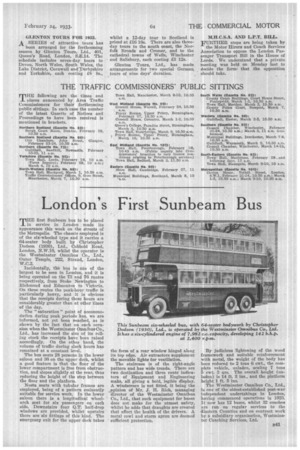London's First Sunbeam Bus
Page 55

If you've noticed an error in this article please click here to report it so we can fix it.
THE first Sunbeam bus to be placed in service in London made its appearance this week on the streets of the Metropolis. The chassis employed is of the six-wheeled type and it carries a 64-seater body built by Christopher Dodson (1930), Ltd., Cobbold Road, London, N.W.10, whilst the operator is the Westminster Omnibus Co., Ltd., Outer Temple, 222, Strand, London, W.C.2.
Incidentally, the bus is one of the largest to be seen in London, and it is being operated on the 73 and 76 routes respectively, from Stoke Newington to Richmond and Edmonton to Victoria. On these routes the peak-hour traffic is particularly heavy, and it is obvious that the receipts during these hours are considerably greater than at other times of the day.
The "saturation" point of accommodation during peak periods has, we are informed, not yet been reached, as is shown by the fact that on each occasion when the Westminster Omnibus Co., Ltd., has increased the size of its rolling stock the receipts have been raised accordingly. On the other hand, the volume of traffic during slack hours has remained at a constant level.
The bus seats 28 persons in the lower saloon and 86 on the upper deck, whilst a good feature is that the floor of the lower compartment is free from obstruction, and slopes slightly at the rear, thus reducing the height of the step between the floor and the platform.
Nests seats with tubular frames are employed, being of a pattern eminently suitable for service work. In the lower saloon there is a longitudinal wheelarch seat for six passengers on each side. Downstairs four Q.T. half-drop windows are provided, whilst upstairs there are six fittings of this kind. The emergency exit for the upper deck takes
the form of a rear window hinged along its top edge. Air extractors supplement the movable lights for ventilation.
The staircase is of the right-angIe pattern and has wide treads. There are two destination and three route indicators of Equipment and Engineering make, all giving a bold, legible display. A. windscreen is not fitted, it being the opinion of Mr. J. H. Rich, managing director of the Westminster Omnibus Co., Ltd., that such equipment for buses does not make for the utmost safety, whilst he adds that draughts are created that affect the health of the drivers. A metal cowl and storm apron are deemed sufficient protection. BY judicious lightening of the wood framework and suitable reinforcement with metal, the weight of the body has been reduced to 2 tons 6 cwt., the complete vehicle, unladen, sealing 7 tons 5 cwt. 3 qrs. The overall height (unladen) is 14 ft. 3 ins., and the platform height 1 ft. 5 ins.
The Westminster Omnibus Co., Ltd., is one of the oldest-established post-war independent undertakings in London, having commenced operations in 1923. It now has 12 buses, whilst 22 coaches are run on regular services to the Eastern Counties and on contract work by a subsidiary organization, Westminster Coaching Services, Ltd.




























































































